|
"You have had something invaluable, and which cannot be purchased."
I know very little about Mary Charles the person. There is a Mary Charles dossier among the archives
at the National Air and Space Museum (NASM). Many of the images which follow came from those files. Below is a photograph from that collection, ca. 1930s.
Mary Charles, Ca. 1930s (Source: NASM)
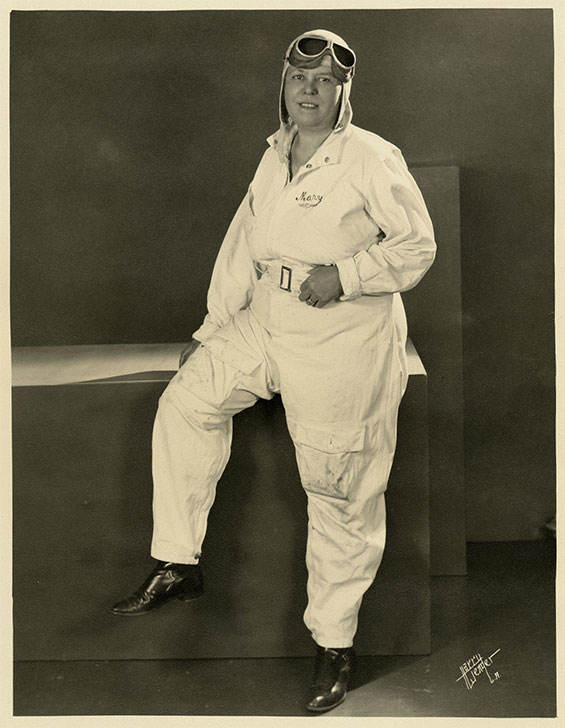 |
She was married (referred to as "Mrs." in several documents and her husband is named in the 1940 U.S. Census, see below). But she doesn't mention her husband in any of her writings. If you can fill in the blanks, please let me KNOW. I especially
need other photos.
Mary Charles received flight instruction in 1929 at Clover Field, Santa Monica, CA. Her instructor was Register pilot Burdette Fuller. Her first solo flight was July 27, 1930. She earned and flew with pilot certificate #17050. One NASM file contains scrap books that carefully organize her letters and news articles referring to her air race experiences. Some of her letters and her experience with the 1931 National Air Races (NAR) follow.
Below, from her NASM folder, is a letter from her to her older sister, Leanora Edith Henry, "Ora." It describes the circumstances around her first solo flight. It is undated, but it is probably early August, 1930. This is a charming letter, filled with sisterly humor, which uses typography to embellish her newsy story. Unfortunately, I had to work with a bad copy, which I enhanced in PhotoShop as best I could. It's a worthwhile read, especially in this age of email, where people just don't take the time to compose longer correspondences.
Mary Charles to Sister Leanora, Page 1, Date Unknown (Source: NASM)
 |
Page two follows. She made a marginal note to clarify her flight instructor's proclivity to search for golf balls. It says, "There's a golf course adjoining field & Fuller is always on the look out for lost balls & often had me taxi over where he thought he saw one!"
Mary Charles to Sister Leanora, Page 2, Date Unknown (Source: NASM)
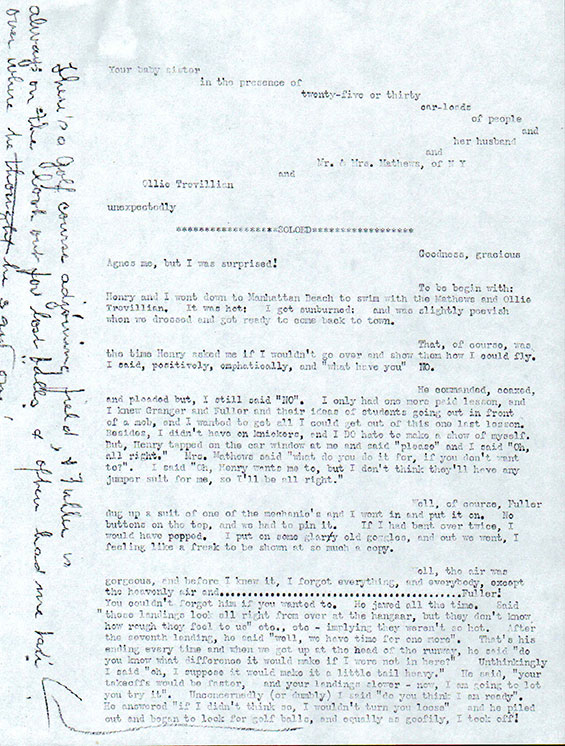 |
Page three follows.
Mary Charles to Sister Leanora, Page 3, Date Unknown (Source: NASM)
 |
About six months after she received her pilot license, she received this letter, below, from the Department of Commerce (DOC) calling her for an infraction of regulations. That letter, dated February 12, 1931, was signed by Tucson pilot Gilbert Budwig, who was then Director of Air Regulation for the DOC. She was fortunate to only be given a warning and be grounded for a day (see letter following this one).
DOC Letter to Mary Charles, February 12, 1931 (Source: NASM)
 |
On February 18th she wrote her sister with a request to place some significant data in her bible. She identifies the date of her first solo flight, July 27, 1930, and alludes to the above letter from the DOC. She wanted that letter to be placed in her bible for some reason.
Mary Charles Letter, February 18, 1931 (Source: NASM)
 |
She also alludes to a conflict with Jim Granger regarding her potential acquisition of an "agency," probably an aircraft sales agency. Jim Granger operated Granger, Inc. at Clover Field and was the agent/distributor for Black Hawk and Swallow aircraft. It is not clear which agency caused Granger to be, "... dumbfounded, hurt, and the rest."
Mary Charles was sister to many female aviators who signed the Register. Below, she is shown (ca. 1929) with (L-R) Clema Granger, Mary, Gladys O'Donnell, Patty Willis (signed the Clover Field Register), Pancho Barnes and Mildred Morgan. They stand in front of Ruth Elder's airplane. Compare this photograph with the one on Pancho Barnes' page. The photos were clearly taken on the same day, with Ruth probably serving as photographer.
Mary Charles With Other Female Pilots (Source: Web)
-1929.jpg) |
Another photograph of the same women, dated 1931, is below. This is an interesting juxtaposition, because the women and their clothing are the same (look carefully and note Granger is in a dress in both images, although she wears the same jacket below and in the photo at Barnes' link). This suggests the photos were taken the same day, and that the news article below displays the accurate date. The uniforms are those of the Women's Air Reserve (see below). Further, the 1931 NAR transcontinental air derby for women began that day, so these pictures were probably taken before 2PM when the women's derby took off at one minute intervals bound for Cleveland, OH.
Mary Charles with other Female Pilots, August 23, 1931 (Source: NASM)
 |
The 1931 NAR drew flyers
from around the country to Cleveland between August 29 and September 7.
Mary Charles participated in the 1931 NAR from Clover Field, Santa Monica, CA to Cleveland, OH, the conclusion of which brought her to the Davis-Monthan Airfield on her way back west (see below). Below are memorabilia from the Race from Charles' scrapbook.
Memorabilia, 1931 National Air Race (Source: NASM)
 |
Another page in her scrap book exhibited the typewritten itinerary for the 1931 transcontinental event from Santa Monica to Cleveland, below. Another bad copy, I adjusted the contrast of this image for better readability.
Itinerary, 1931 National Air Races, Transcontinental Handicap Air Derby, Santa Monica, CA to Cleveland, OH (Source: NASM)
 |
Undated News Article, Ca. August, 1931 (Source: NASM)
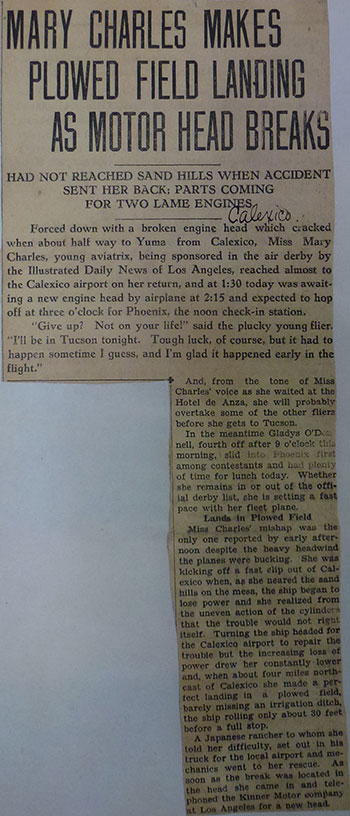 |
Charles formally entered the transcontinental event, but she did not place (she actually came in last), and was not listed among the winners in the 1932 Aircraft Yearbook (which reported on the 1931 race). She did, however, place third in Event 35, the dead stick landing competition (without brakes) on August 31st. She won $40 for her efforts, which, in those days, might have been enough to pay for her gasoline on her way back home. The airplane she used was identified as a Swallow.
Notably, during and after the transcontinental event, she passed through St. Louis and signed the Register of the Parks Airport twice, going to (8/28/31) and from (9/8/31) Cleveland. Both times she was flying the Swallow TP-K she identified as NC684H (S/N 209).
Perhaps one reason she did not place in the cross-country event was because of a forced landing endured between Calexico and Yuma, AZ shortly after the race began. This landing was caused by a failed cylinder head, as reported in the undated news article, left. She elected to return to Calexico rather than risk a landing in the sand dunes closer to Yuma.
Her spirit was unbowed, however, stating that she would make it to Phoenix and then Tucson, AZ for the scheduled overnight. It is clear that repairs were effected that day and that she remained near the event's itinerary and timing, because she was signed in the Parks Airport Register on August 28th in accordance with the schedule above. Despite her timely presence at Parks Airport, she still came in last.
Homeward bound, Charles landed
solo at the Davis-Monthan Airfield with NC684H on Saturday, September
12th at 10:30 in the morning. It had taken her four days to fly from Parks Airport in East St. Louis, IL to Tucson. She arrived at Tucson from El Paso, TX and cited Santa Monica as her destination.
A letter to her sister, among her NASM biographical materials, exactly places her in Tucson on that day. It is unusual to find a letter that so exactly describes the context of a landing at Tucson. That letter, dated September 21st, is below. Mention of Tucson is near the bottom of this page. I'm not sure of the significance, if any, of the letterhead. She carried a passenger from Cleveland, a Mr. Edwards. He wasn't logged in the Parks Airport Register and neither was he mentioned at Tucson. It appeared from the letter that he deplaned at Marshall, MO, considerably west of East St. Louis, which would suggest his not being logged at Parks was an oversight. Note in the letter that Jim Granger was against Edwards accompanying her. Aerial hitchhiking, or "godunking" was common during the Great Depression.
Mary Charles Letter, September 21, 1931 (Source: NASM)
 |
Passenger or not, her flight between Tucson and the west coast was interrupted by mechanical problems and weather (wind, fog and heavy rain). And she lost another cylinder at Aztec, AZ some miles east of Yuma and landed on a road. Her railroad track guidance ran nearby.
Below, page 2 of her letter. Notice the common pins in the left margin of the page above. These were used to fasten the letter pages together, and the second page was pasted to the scrapbook page. Thus the gentle fold at the left margin of the top page I had to make to photograph the page.
Mary Charles Letter, September 21, 1931 (Source: NASM)
 |
Notably, we learn the familiar name "Babe" was used by Charles with her family. Note, too, mention of Jim Granger, who paralleled Charles' itinerary through Tucson after the NAR (he signed the Register two lines ahead of Charles). She was greeted upon her return at Santa Monica by Register pilot Burdette Fuller.If anyone can provide insight for other entities mentioned in this letter, please let me KNOW.
Records in the International Ninety-Nines Museum in Oklahoma
City state that Mary had accrued 110 flying hours as of 1932. Thus, she was a novice (and brave) pilot during the 1931 race.
Another of her NASM files contains among other things, a detailed 1935 document describing and providing an organizational template for an official Women's National Air Corps (WNAC). The sub-theme of the Corps was "Peace by Preparedness." The folder contained the following logo that was designed for the Corps. It was sketched in pencil. Marcy was unidentified.
Women's National Air Corps Wings Design, 1935 (Source: NASM)
 |
To my knowledge, her full plan for the WNAC was never activated. However, the Women's Air Reserve (WAR), another attempt to organize female pilots in a military manner, did develop and publish their regulations. A copy of the regulations from Charles' NASM folder is at the link (PDF 2.9mB). These regulations appeared as an 8.5" x 5.5" pamphlet, staple-bound at the fold. The WAR had a separate, typewritten list of demerits that did not appear in the WNAC document. That list follows.
Women's Air Reserve, List of Demerits, Ca. 1935 (Source:NASM)
 |
The wording and sections of the WAR document borrow heavily from the texts she developed for the WNAC. Notice the similarity in the wings badge design on the last page of your downloaded document. More broadly, a few years later, the Women's Army Corps (WAC) and Women's Air Service Pilots (WASP) of WWII assumed the organizational characteristics that were outlined by Charles ca. 1934.
In 1934, WAR pilots planned and executed a coast-to-coast flight, with sponsorship by the Gilmore Oil Company, to advance aviation. Below, sponsor Gilmore featured the flight in its September, 1934 newsletter. Besides the pilots I linked above, Opal Kunz was also involved in WAR.
Gilmore Newsletter, September, 1934 (Source: NASM)
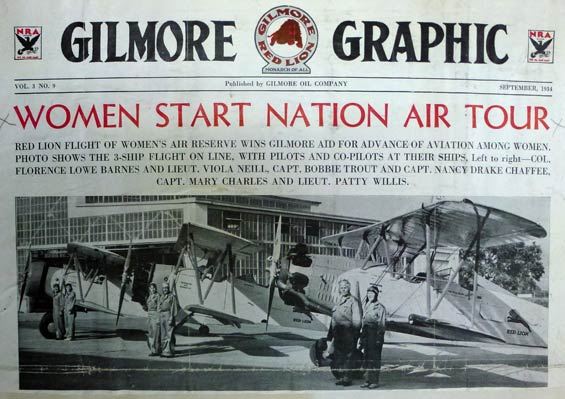 |
Six women and three airplanes participated. The flight was further documented in newspapers, below. Their eastbound itinerary is cited.
Undated & Unsourced News Article, Ca. 1934 (Source: NASM)
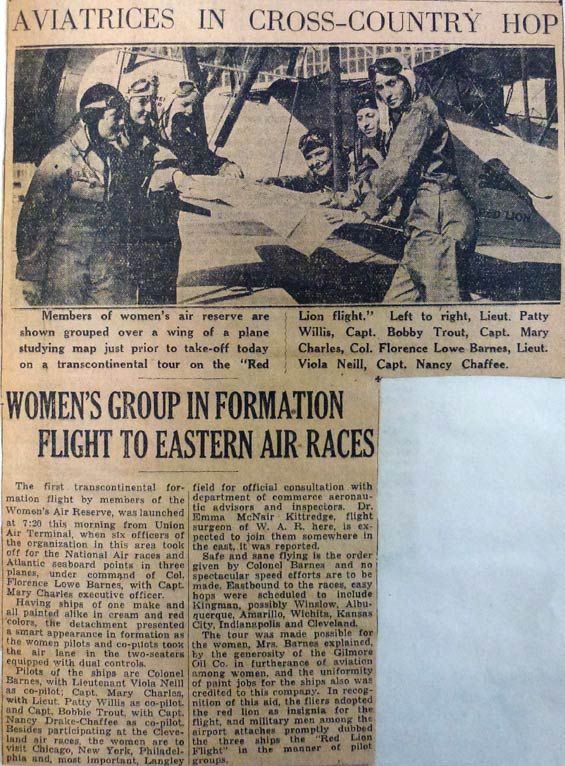 |
Undated News Description of Charles' Crash, Ca. 1934 (Source: NASM)
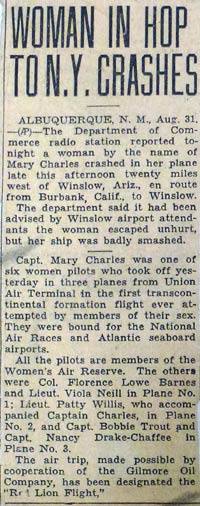 |
Gilmore Oil had the airplanes uniformly painted (cream & red), and placed the Gilmore lion logo on the fuselages. Charles didn't complete the flight as detailed in the unsourced news article at left. She barely made it across Arizona before she and her copilot crashed. They destroyed their landing gear and both were shaken up, but not injured.
This same folder contains her Federation Aeronautique International licenses for 1931 and 1932. I was unable to photograph them. Her date of birth on the licenses specifies March 17th. No year was given, probably in deference to the custom of women of the era not wanting their exact age known.
Mary Charles, Miniature Watercolor, 1937 (Source: Stephens)
 |
Mary remained active in flying at least through 1934. The three-plane, first women’s
transcontinental formation flight from Union Air Terminal,
Los Angeles to Roosevelt Field, NY documented above appears to be the last flight of any significance she attempted.
Interestingly, she had a miniature water color portrait painted by artist Myrtle Matlick ca. 1937. At right, courtesy of Matlick's granddaughter, Carol Stephens, is an image of that portrait. It shows her in helmet and goggles. Ms. Stephens states about the piece and her grandmother, "I do not know any specifics. I suspect she painted it for the purpose of entering it in the exhibition.... She lived in Pasadena and painted many portraits. It's possible she knew/met Mary Charles, but I have no proof of it." And further, "Art needs to be shared and enjoyed." The original portrait is 2" x 1-1/2".
According to a site visitor, Henry F. Charles died in 1942 and left Mary impoverished. She worked
for the military during WWII near Fresno, CA. A 77-page mimeographed report in her NASM folder (not downloadable from this page) states that she was the coordinator of civilian training during at least November-December, 1942 at the 55th Sub-Depot, Army Air Base, Lemoore, CA.
In a diary kept by Mary, we learn that her mother was Narcissa Ann Wesson Henry. The 1940 U.S. Census has Mary living with her husband, (age 50), at 2718 Reservoir St., Los Angeles, CA. Google Earth shows this address today as a modest, single-storey home with an orange tree in front. He and Mary (age 40) shared the house with "Anna W. Henry," who was probably Narcissa Ann Wesson Henry (89), who passed away later in 1940. From the Census, both Mary and her mother enjoyed a four-year college education. I could find no earlier or later U.S. Census data.
When I spoke with Bobbi Trout, who was friends with Mary, she said that before WWII
Mary’s husband sold pipe organs to theaters in the Los
Angeles area. According to Bobbi, soon after the
war, Mary became reclusive in Santa Monica, declining to visit
even with old friends, like Bobbi, who called on her.
---o0o---
Dossier 2.4.17
THIS PAGE UPLOADED: May, 2005 REVISED: 03/23/10, 08/23/16
|








-1929.jpg)











